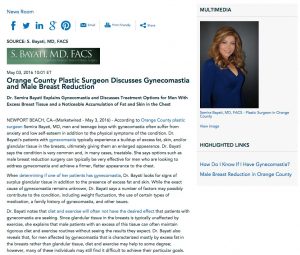
Dr. Semira Bayati explains gynecomastia and discusses treatment options for men with excess breast tissue and a noticeable accumulation of fat and skin in the chest.
Newport Beach, CA – According to Orange County plastic surgeon Semira Bayati, MD, men and teenage boys with gynecomastia often suffer from anxiety and low self-esteem in addition to the physical symptoms of the condition. Dr. Bayati’s patients with gynecomastia typically experience a buildup of excess fat, skin, and/or glandular tissue in the breasts, ultimately giving them an enlarged appearance. Dr. Bayati says the condition is very common and, in many cases, treatable. She says options such as male breast reduction surgery can typically be very effective for men who are looking to address gynecomastia and achieve a firmer, flatter appearance to the chest.
When determining if one of her patients has gynecomastia, Dr. Bayati looks for signs of surplus glandular tissue in addition to the presence of excess fat and skin. While the exact cause of gynecomastia remains unknown, Dr. Bayati says a number of factors may possibly contribute to the condition, including weight fluctuation, the use of certain types of medication, a family history of gynecomastia, and other issues.
Dr. Bayati notes that diet and exercise will often not have the desired effect that patients with gynecomastia are seeking. Since glandular tissue in the breasts is typically unaffected by exercise, she explains that male patients with an excess of this tissue can often maintain rigorous diet and exercise routines without seeing the results they expect. Dr. Bayati also reveals that, for men affected by gynecomastia that is characterized mostly by excess fat in the breasts rather than glandular tissue, diet and exercise may help to some degree; however, many of these individuals may still find it difficult to achieve their particular goals.
Fortunately, Dr. Bayati says male breast reduction options can often effectively address aesthetic concerns related to gynecomastia. She notes that liposuction alone may be all that’s necessary in cases where excess fat in the breasts is the main source of gynecomastia, while surgical tissue excision can help recontour the breasts for men who have excess glandular tissue and/or skin in the chest area. In some instances, Dr. Bayati explains, a combination of the two techniques may be necessary for the best results. Even though cases of gynecomastia vary from patient to patient, Dr. Bayati says she can customize male breast reduction surgery to meet the needs of the individual.
Dr. Bayati notes that men who are concerned about gynecomastia and considering their treatment options should consult with a board-certified plastic surgeon who can examine their needs and talk with them about their options. She says many of her patients who have been treated for this common condition have achieved their goals with natural-looking results, and often experience a boost in self-confidence after the procedure.
About Semira Bayati, MD, FACS
Dr. Semira Bayati is certified by the American Board of Plastic Surgery. She graduated from the Boston University School of Medicine with honors and went on to complete her General and Plastic Surgery Residency training at the Southern Illinois University School of Medicine, followed by completion of a Fellowship Program at Loma Linda University Medical Center. A Diplomate of the American Board of Plastic Surgery, Dr. Bayati is also a member of the American Society of Plastic Surgeons, the American Medical Association, and the American Society for Aesthetic Plastic Surgery. Dr. Bayati is available for interview upon request.
For more information about Dr. Bayati’s practice, visit drbayati.com or facebook.com/drbayati.
Contact:
S. Bayati, MD, FACS
20311 SW Birch Street
Suite 200
Newport Beach, CA 92660
(949) 756-0400
Rosemont Media
(858) 200-0044
www.rosemontmedia.com


